
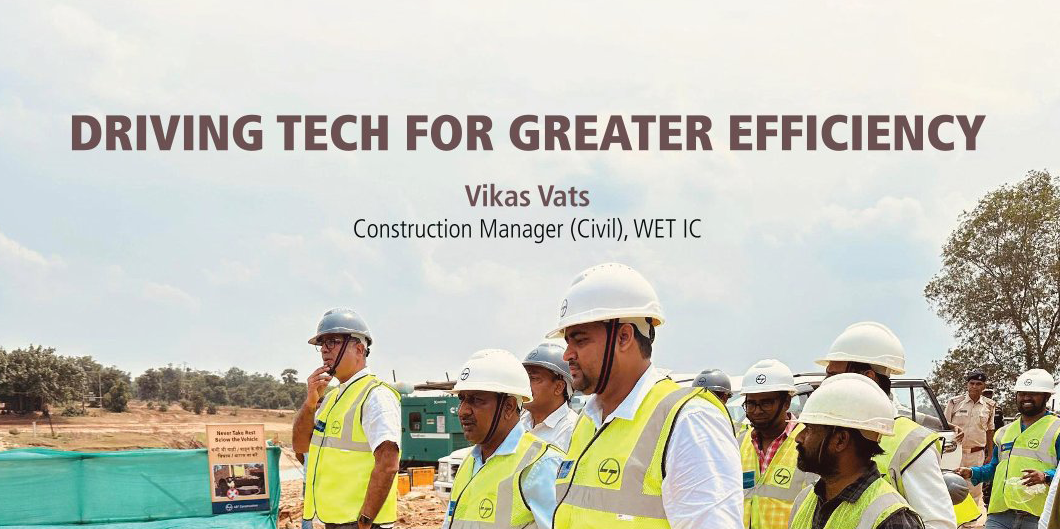
Having joined the L&T family in 2015 as a GET, Vikas Vats has gained valuable experience at WET projects like UFW-D2a, Bangalore; Ganga River Front Project, Patna; and SKGLIS, Garhwa; since May 2022, he has been Planning In-charge at the Masalia Ranishwar Project. “I have helped implement several innovative digital initiatives at my projects to enhance safety, efficiency, and progress monitoring,” Vikas begins, highlighting that geospatial technology in particular has been most beneficial for irrigation projects that involve thousands of kilometres of pipeline.
LiDAR for precise topographic mapping and site assessments has significantly improved the accuracy and reduced survey time from 6 months to just 15–20 days. “We won the DX Award in 2022 for Best Practice in Digital Transformation in the ‘Innovative’ category, thanks to this initiative!” Vikas beams. “All thanks to proper planning and guidance from our EDRC team.” The ConPro platform to onboard batching plants, optimize concrete production to match requirements, and reduce wastage also wins his appreciation, which throws up real-time insights into production and asset utilization. “We have taken help from Heavy Civil IC and the SCHWING Stetter back-end team to integrate the software to monitor the production process of batching plants,” he notes.
The high-definition camera in the OPTICVYU system at the barrage location gives real-time updates on project progress, enabling quick decision-making and prompt interventions. “With our advanced monitoring system, stakeholders receive continuous updates on key project milestones, resource allocation, and potential risks.”
“I would not have been able to implement all these initiatives without my Project Manager Mr. Srinivasakan’s help,” Vikas shares with a grateful smile. “With the support of my team members, we have developed a truly digitally implemented site.” Vikas believes that establishing pilot programmes at select sites and a reward programme will help drive tech adoption further. “BIM and AI for predictive modelling, risk analysis, and quality control will go a long way in optimizing our construction,” he observes. “AI can also be used to automate tasks such as scheduling and material ordering, freeing up time for more complex tasks.”
Creative Vikas likes to be active. A native of Nawada in Bihar, he is married to Kumari Bhawna Vihar, a software engineer working at IBM Kolkata. His most memorable day is 11 July, when his daughter, Hitakshi, was born and he received a promotion as well – “I was promoted both personally and professionally that day!” he remarks with a laugh.


PLAYING HIS ROLE TO THE HILT
Md Kashif Raza Ansari
Senior Engineer (Civil), WET IC
At his first assignment with L&T, posted at the Ranchi Cluster, young Md. Kashif Ansari is enjoying his work of supporting business operations such as on-time vendor payment, client outstanding follow-ups, financial parameters & statutory compliance updates, procurement, analysis of EHS/ quality observations, and more particularly, various digital solutions deployed at the site.
“With Opticvyu, we get a 24×7 virtual, sequential outlook of project progress with timelapse video for on-time corrective actions if any, while Asset Insight helps us to monitor and control our batching plants for ensuring optimum utilization and minimizing wastage,” he shares excitedly.
Earlier, issuing materials at stores was a long and tiresome task, but with Material NxT, life has changed for people like Kashif, for now indents are made digitally and subcontractors issue material through a mobile app. “Since our site is remote, we faced bandwidth issues, but we overcame the network problems by taking a 10 Mbps leased line from Ishan Nestol in collaboration with Airtel.”
Kashif is not finished with his list of digital solutions, mentioning ViewEHS that is providing the team better insights on risks to be better prepared to take corrective action immediately. “QIR enables us to identify defects timely for early corrections,” he adds. “We have used LiDAR to survey 32,000 hectares of gross command area, which has given us accurate, high-resolution, three-dimensional mapping, while with an integrated Geospatial Dashboard, we monitor the progress of pipelaying activity in real time and instantly identify gaps.”
He is convinced that L&T will succeed in its journey of digital transformation because of its unmatched capabilities across technology and engineering. “It has set benchmarks in the field of quality too.” Looking ahead, he says, “AI integration should be done so that we do not have to make a new PPT for every meeting. There should be a single dashboard to enter all financial data like costs, sales, invoice, etc., which will generate the required details and project focus areas.
In his journey as a Tech Champ, Kashif is grateful for the support and guidance of his seniors from project sites, Sai Vaidyanathan and his IS K Dhanushkodi’s mentorship. “Always supportive, he has guided me to make sensible decisions,” he says thankfully.



A native of Asansol, West Bengal, which he refers to as ‘the city of brotherhood’, Kashif is single, and his present loves are travelling & exploring new places. Recalling a life-defining moment, he shares how he was stuck in the mountains of Sikkim for 7 days without food until the Army rescued him during the October 2023 landslide. “That experience has taught me to see life positively and become mentally strong and calm.”
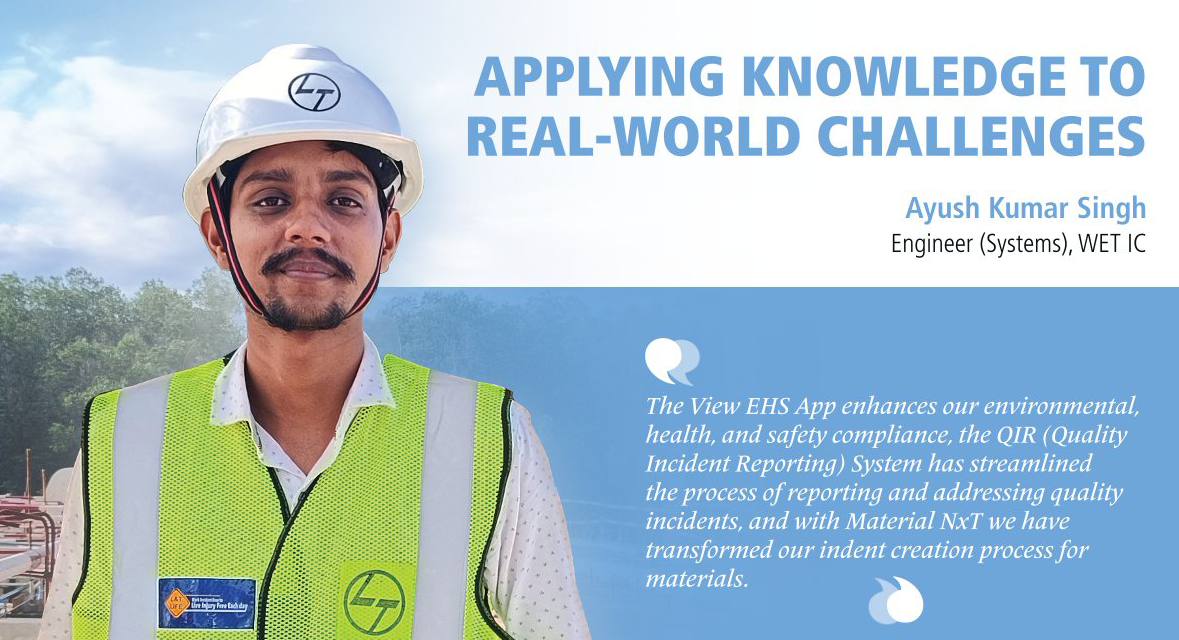
An initial 6‑month stint at L&T’s Chennai Headquarters, taught Ayush Kumar the ropes about the company’s systems, protocols, and best practices in system engineering and now, at the Masalia Ranishwar LIS Project site as Systems Engineer, he is finding opportunities to apply that knowledge to solve real-world challenges, collaborating with a dynamic team. His primary responsibilities involve designing and implementing optimized cloud infrastructure solutions, continuously monitoring system performance, and IT support, and ensuring robust security compliance.
Certainly, technology is close to his heart for Ayush readily flags off the team’s various digital applications. There is the WISA App to maintain accurate workers’ attendance records, LiDAR for efficient surveys, Asset Insight for real time asset monitoring, the ConPro App to schedule concrete production, and Geospatial Technology to identify gaps especially during pipe laying. “The View EHS App enhances our environmental, health, and safety compliance, the QIR (Quality Incident Reporting) System has streamlined the process of reporting and addressing quality incidents, and with Material NxT we have transformed our indent creation process for materials,” he says, with fervour.
“Our site has two site offices where I maintain all IT assets and provide IT support as an ISD person,” he points out, mentioning that their IT infrastructure is secured by firewalls and supported by two separate ISPs, each providing a 20 Mbps ILL connection to both offices. “Our site is equipped with BIM too, a high-definition VC system, and multiple IT assets. I rectified an EIP issue at site, taking care of HDs for HAM & SAM,” he shares.
By leveraging advanced technologies, Ayush is thrilled that the team has enhanced accuracy, efficiency, and safety. “I am proud of our progress and am committed to innovate by implementing solutions that benefit our project and the organization, as a whole.” For him, L&T is an organization that values innovation, integrity, and sustainable development. “This not only challenges me professionally but also aligns with my personal values of striving for excellence and making a meaningful impact.”
Ayush acknowledges the significant influence his seniors and team members have had on him. “I have been mentored by my IS, Srinivasakan M, and DH, Anand Srinivasan, as well as the ISD and Digital HQ teams, and our collaborative environment with the Cluster, Digital, and Project site teams fosters innovation,” he emphasizes.
Hailing from Daltonganj, Jharkhand, and single, Ayush loves to gain in-depth knowledge of Indian polity and write articles on it.

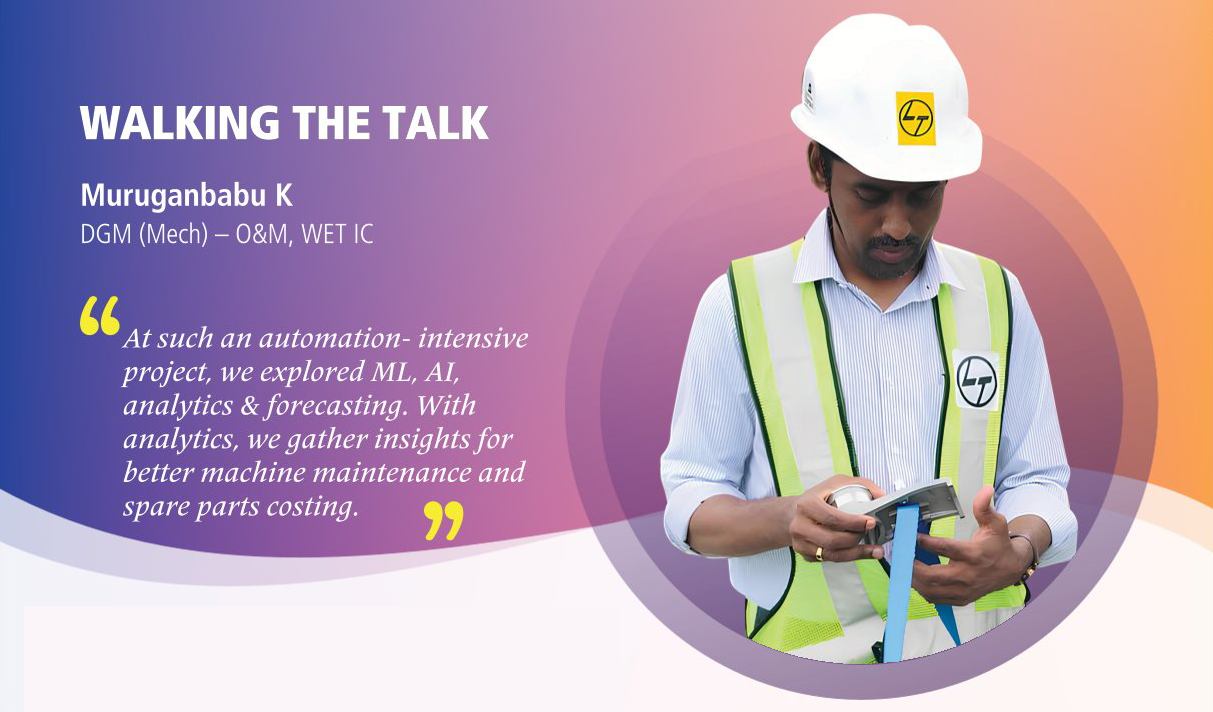
A veteran of 33+ years with L&T, K Muruganbabu’s learning & experience come alive through his actions of having worked in multiple areas, to upskill and enhance the reliability of the mechanical components. Currently at the UP Tubewell Scheme project, his prime responsibility is to provide technical & O&M support on the mechanical portion of all 58 ongoing WWW projects.
Mandated to construct & integrate 3,000+ borewells across 7 districts of UP, Muruganbabu describes the project as one of the first to implement water management through automation. “It is important to effectively maintain the many assets in the tubewell with zero downtime to achieve operational and financial goals. Longer the life of the asset, better is our productivity,” he observes.
The Computerized Maintenance Management System (CMMS), implemented to provide a standard, scalable and automated technology platform to digitize the O&M process, bridges the strategic management and operational layers, by translating the goals into operational metrics and automating the fragmented maintenance information to process information better and deliver operational excellence. “CMMS has been implemented across all jobs with contract periods of more than 3 years,” he informs, “which helps us in preventive & predictive maintenance and condition-based monitoring.” At select sites, IoT sensors implemented in critical assets like VT and HSC pumps provide real time data of temperature, vibration and noise and alerts to help early intervention. Muruganbabu and team beam with pride pointing at the ‘Innovative Digital Solution’ trophy they won in 2020 for this initiative.
Learning never stops for Muruganbabu. “At such an automation-intensive project, we explored ML, AI, analytics & forecasting,” he says. A major challenge was prescriptive troubleshooting for pumps & Instruments, having to work with logic, rules, formula, etc. assuming key likely-to-happen scenarios. Unique asset codes with the required logic were developed for 80,080+ equipment, for better machine efficiency and chemical optimization. “With analytics, we gather insights for better machine maintenance and spare parts costing,” he points out, adding that they succeeded by collaborating with multiple OEMs, internal stakeholders, and learning from technical journals.
His Boss is his mentor, and he is fully supported by his seniors and colleagues. Looking ahead, Muruganbabu is keen to learn and implement remote monitoring & asset management through IoT sensors & cloud-based platforms, to manage assets better, improve reliability & availability for sustainable business efficiency.
Married to Sakthirekha, a homemaker, they are blessed with a son, Santhosh M. Hailing from Chinnalapatti in Dindigul district, he loves to do yoga and read. His son’s birth and completing his B.Tech. course are moments he cherishes the most. On a continuous journey of learning, Muruganbabu is proud to be a part of India’s largest Nation builder.


From his childhood days, Prasanna Venkatesh dreamt of becoming an entrepreneur. In December 2012, his dream was realized when he joined L&T as the first instrumentation engineer in WET EDRC. Commencing as a design engineer, he has transitioned into a Department Head. “Being an engineering project manager for multiple projects has enriched my cross functional understanding, networking skills and customer focus,” he shares with a clear sense of purpose, “while as MIS for EDRC has helped me develop my leadership skills.” He is especially pleased for having drawn up a road map for the instrumentation department.
As the task force leader of the Unified Common Command Centre (UC3 ) initiative, Prasanna views himself as an intrapreneur, constantly seeking opportunities to implement new technologies and particularly passionate about the UP Tubewell Project, which he believes could be a significant breakthrough for his entire team. “A risk review meeting with SNS triggered the automation idea, and with EPS, we drew up the roadmap for digitalization,” he shares, looking charged. “This was the beginning of the team’s research to develop the UC3 .”
As the flow of data from across 3,000+ tubewells had to be seamlessly captured and analysed, the project has been divided into 5 levels, each empowered with various technological interventions in the areas of asset management, predictive & prescriptive maintenance and others to enhance operational efficiency.
“To enhance our systems and transit from Operation Technology (OT) to Information Technology (IT), we are building a strong OT foundation with an emphasis on remote terminal unit (RTU), VSAT, and triple redundancy with quaternary backup architecture based on hybrid cloud concept,” informs Prasanna, “and the transition from GPRS to VSAT has helped us overcome the communication limitations between the remote Gram Panchayats and Data Centres.” Initiatives like integrating 32,000+ field instruments, 8.5 lakh SCADA tags, and AI to the UC3 are resulting in quicker project delivery and improved accuracy & efficiency.
Integrating advanced technologies, managing large volumes of real- time data, multiple location coordination, resource constraints, and gaining buy-ins of stakeholders were major challenges that the team faced and overcame.
Prasanna revels in the collaborative environment of continuous learning, constructive feedback and relentless guidance from his seniors and support from his team members. To drive tech adoption, he suggests continuous learning, professional development, structured training programmes and improved stakeholder engagement.
Hailing from Dindigul, Tamil Nadu, Prasanna’s most cherished moments are when his two daughters, Ananya and Shraddha, were born. His wife, Kalaiselvi, an ex‑L&T employee, now runs her own organization serving E&I needs for multiple sectors. He loves listening to music, spending time with his family, and pursuing his passion for cycling.
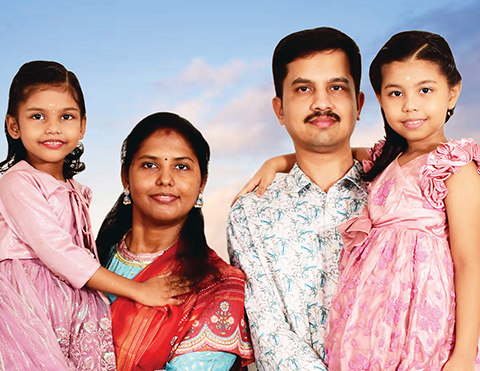


A passionate Instrumentation expert, Prabhakaran Nagaraj is proud of L&T’s lead role in the water treatment & supply space and that pride has translated into an outstanding track record. “I have implemented sophisticated Programmable Logic Controller (PLC) / Supervisory Control and Data Acquisition (SCADA)–based automation systems across 40 projects, to significantly enhance control and monitoring of pumping stations, water treatment plants, and ESR/DMA systems, including chemical dosing processes, chlorination & ozonation,” he shares with gusto. “This system also encompasses advanced diagnostics, predictive and preventive maintenance and closed loop PID operations.”
Once started, there is no stopping his passion. “I have integrated remote control capabilities utilizing GPRS/GSM, VSAT, RF, and fibre optic communication, to ensure real-time monitoring & control, which has remarkedly improved efficiency, minimized downtime and optimized operational processes, accelerating project delivery.”
He obviously loves what he is doing considering his journey across scores of projects with L&T: 10 so far as Section Head for the Instrumentation discipline for UW&WM EDRC, where he is responsible for the timely delivery of design documents/drawings and vendor engineering. Before that, Prabhakaran handled 22 projects as Lead Manager for WSD EDR, and even prior to that as Instrumentation & Automation Design Engineer, he successfully designed for 13 projects.
Despite all the tough challenges he faces during the designing stage, Prabhakaran says, breaking into a smile, “It is certainly tough to manage stakeholders across 7 districts, coordinate with multiple vendors, develop and implement standards for the communication protocols. Collaboration is the magic word,” he nods, “that has helped the team & me align on all the technical requirements, get everyone on the same page, and promptly address concerns.”
He believes that cloud-based technology needs focus as traditional storage services aren’t adequate for handling large amounts of data cost-effectively and securely.


Continuous learning, upskilling and mentoring from his seniors are what have helped him stay ahead of all the technological developments. “A structured approach to training and focus on emerging technologies will certainly help in quicker implementation and better decision making,” he adds seriously.
Hailing from Irumathur, Dharmapuri district, Tamil Nadu, Prabhakaran likes swimming, reading, visiting museums, and solving crossword puzzles, which provides him with food for thought. Happily married to Gunasundari, a homemaker, they are blessed with a daughter, Niranjana, and son, Sarvesh. Topping in 10th and 12th standards and the days his children were born are his life’s most treasured moments.

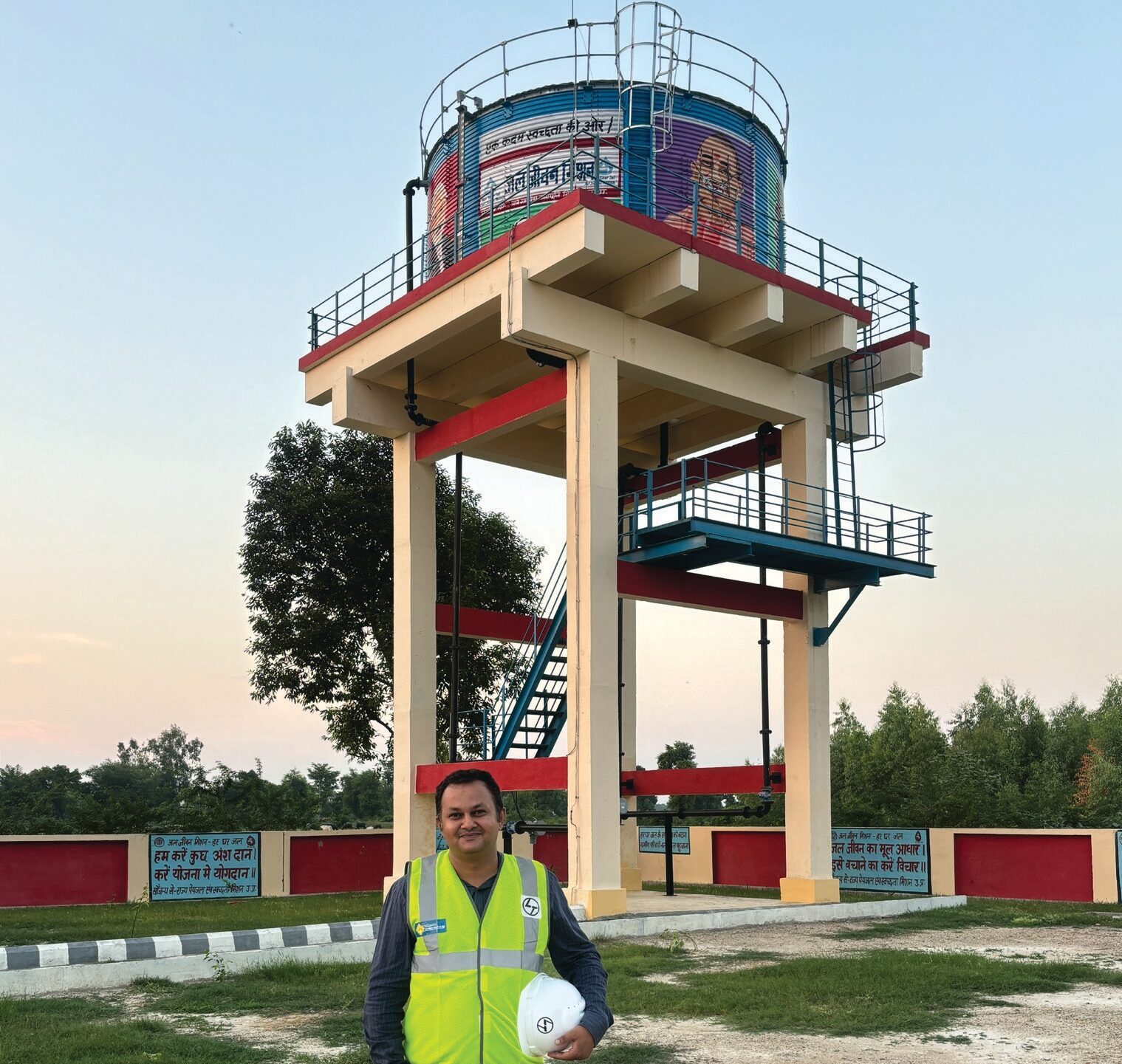

A GET of Batch 2009, Vivek Shahi’s growth at L&T is thanks to the all-round exposure he has been fortunate to enjoy. Right after orientation, he found himself at his first site, PT&D IC’s 220 kV Panarsa–Nalagarh Transmission Line Project, “for some onsite training where I learnt the nuances of project execution, especially in a hilly terrain with inherent geographical challenges,” he shares.
This was followed by a stint at the 400 kV Parbati–Amritsar Transmission Line as Section In-charge. Subsequently, he worked as Project Coordinator for DLRO, Business Development Manager and MIS – N&C Segment, before moving overseas to work at the 500 kV Phayargyi and Hlaingtharyar project in Myanmar as Planning Manager. “It was PT&D’s first project there and I had the opportunity to work with various international agencies from Japan and Myanmar and gained quality experience in overall project management in the international domain.”
Currently, as Manager – Operations for Electrical and Instrumentation (E&I) works, Vivek is a part of a project executing groundwater schemes across 7 districts of UP to provide safe tap water connections to the residents of 3,000+ Gram Panchayats, by operating unmanned tubewells through a unified control command centre relying on wireless data transmission from each Gram Panchayat.
“The operational philosophy relies on the interoperability of various field instruments sourced from different manufacturers,” he elaborates. “We have implemented an a RTU-based control system integrated with dozens of field instruments running on a control philosophy, uniquely customized to meet water and quality demands.” He says that all the RTUs are connected through DNP3 protocols for remote control and monitoring assisted by VSAT, which in turn helps to store and analyse data fetched by the field instruments placed at various locations. A majority of these RTUs and field instruments draw power from solar-based energy sources promoting carbon neutrality at a scale equivalent to 1 lakh tons of carbon emission annually.
Awareness is imperative for E&I works to succeed, he stresses, mentioning the Central E&I Cell formed for uniformity in E&I work across districts, for inter-site coordination, drawing approvals, and a manufacturer-related single point redressal system. Ease of operability will quicken technology adoption, apart from consistent communication, periodic training, and incentives, at least in the initial stages of implementation.
A writer at heart who keeps updating his diary every week, Vivek is married to Kritika Singh, who is a government officer in the Ministry of Health and Family Welfare, UP. “I believe L&T empowers employees even at the bottom of the pyramid, which empowers us to take decisions without the fear of failure,” he signs off encouragingly.
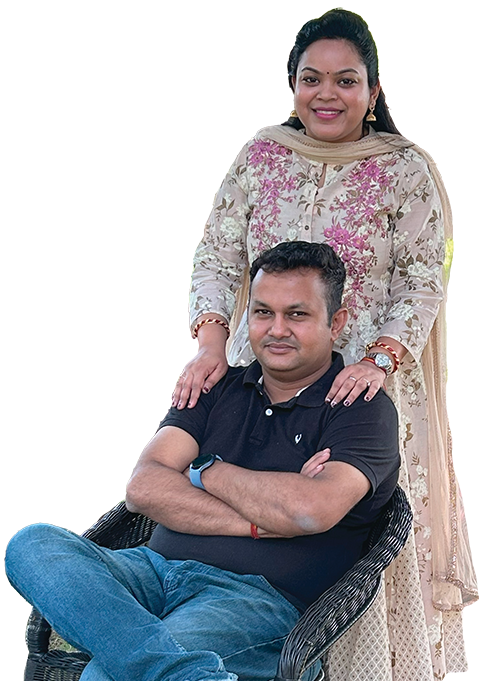
A writer at heart who keeps updating his diary every week, Vivek is married to Kritika Singh, who is a government officer in the Ministry of Health and Family Welfare, UP. “I believe L&T empowers employees even at the bottom of the pyramid, which empowers us to take decisions without the fear of failure,” he signs off encouragingly.

One of most cherished moments that Abhijeet Amnerkar has experienced was when he was recognized by L&T’s top management for his contribution towards customer satisfaction, formulating new procedures, cost reduction and improving facilities and working conditions. “It was a wonderful moment for me,” he gushes and since then, there has been no looking back. “I am proud to be part of a team that prioritizes technological advancements and customer satisfaction and for the opportunity to work on projects that significantly and positively impact communities.”
Working presently at the 24×7 Hubballi-Dharwad DB Operation Maintenance Project responsible for laying HDPE pipes and using advanced technology to improve water management systems, Abhijeet has ample opportunities to do what makes him proud. “We are using some of the world’s best technologies in the water supply system,” he observes, proceeding to mention some of the solutions deployed by the team including the pipeline endoscopy camera, ground microphones, leak noise correlators, portable flow meters, mechanical listings stick and the ArcGis App.
“I am specifically working on the pipeline endoscopy camera to address customer complaints of low pressure, leaks, contamination and/or pipe deformations in networks that are more than 30 years old,” he shakes his head. “The camera, however, is helping us pinpoint problem locations, and we have successfully resolved major historical complaints which had been pending for the past 4–5 years,” he says brightly. Better & equitable water distribution is another one of their deliverables, for which the team conducts micro-level water audits and installs flow meters. “We have even established a 24×7 customer care management system to address grievances swiftly,” he adds.
At his project, Abhijeet feels lucky to be part of a collaborative and healthy work environment with encouraging seniors and alongside motivated and goal-oriented colleagues who are open to readily adopt advanced technologies. To drive it organization wide, he recommends more training programmes to build proficiency and by integrating new technologies more effectively into existing systems.
About improving tech adoption at WET IC, he says, “We require access to advanced data analytics tools for better understanding to manage water supply systems, real time water quality monitoring systems to ensure safe and clean water supply and better integration of IoT devices for better control and management of water distribution.”
Hailing from Nagpur, Maharashtra, and still single, Abhijeet is passionate about listening to music, exploring historical places, and of course, adopting new technologies.
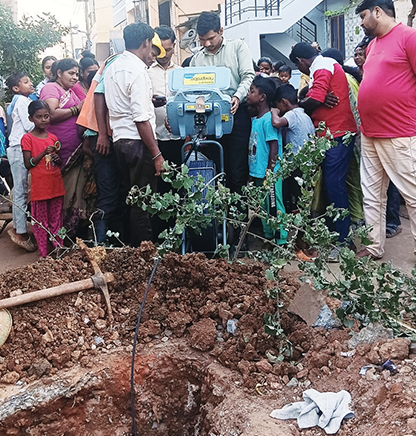

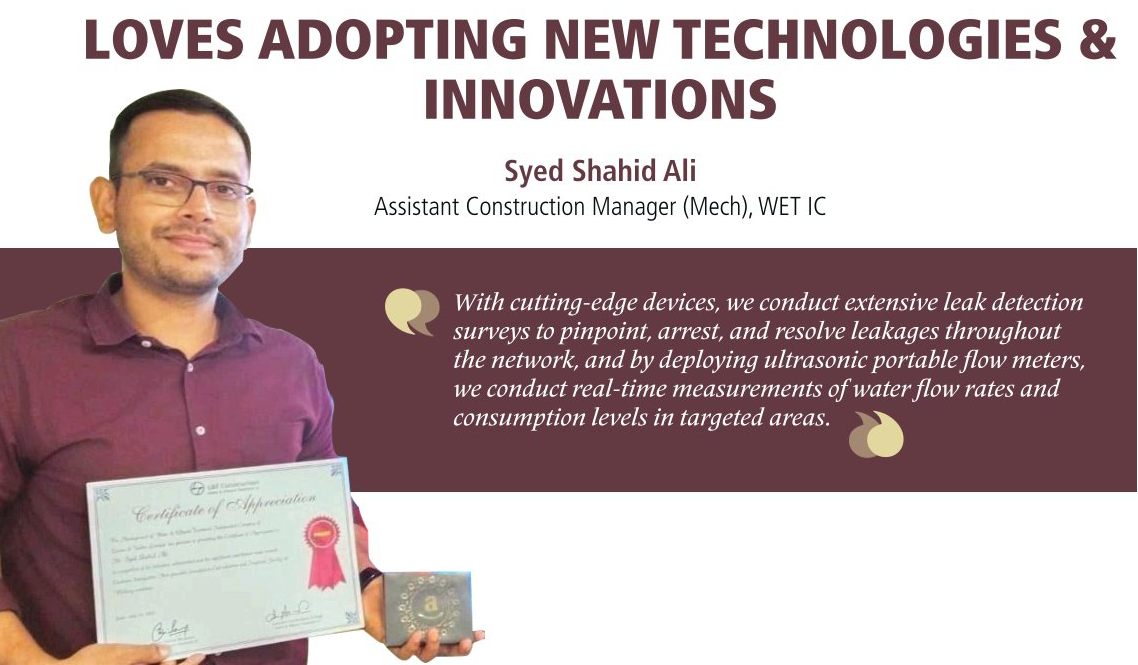
Amongst his several passions, Syed Ali loves to adopt new technologies and innovations. “I am proud of being part of a team at L&T that prioritizes technological advancements and customer satisfaction, and I am happy for the opportunities to work on projects that have a significant positive impact on communities,” he says earnestly.
After beginning his journey with L&T at the Indore city 24x7 Water Supply Project, he is currently at the Hubballi Dharwad 24x7 Water Supply Project looking after O&M and Non-revenue water reduction works, where he shares purposefully, “We are implementing a range of advanced technologies such as portable flow meters, ground microphones, Leak Noise Correlators (LNC), and pipe endoscopy cameras to improve the water supply system.”
Till date, the team has inspected over 350 km of pipeline, identified and resolved over 520 complaints resulting in greater reliability, efficiency, and better quality of water, benefiting 10,000+ households in the region. “With cutting-edge devices, we conduct extensive leak detection surveys to pinpoint, arrest, and resolve leakages throughout the network,” he shares, “and by deploying ultrasonic portable flow meters, we conduct real-time measurements of water flow rates and consumption levels in targeted areas. These flow meters are accurate, non-invasive, and precisely monitors water usage.” The data is then extracted and analysed to identify anomalies, fluctuations, or patterns indicative of leaks or abnormal water usage.
Syed is aware that he and his team are not just constructing a water supply scheme but improving the lives of thousands. “We use pipeline inspection cameras to identify and resolve leaks and contamination issues, conduct micro-level water audits, and even established a 24x7 customer care management system to address grievances swiftly,” he says with due seriousness.
In his effort, Syed finds continuous support and guidance from his seniors to stay updated with the latest technological advancements. “My team members collaborate effectively, by sharing insights and feedback to optimize the implementation of new technologies,” he remarks. To drive technology adoption faster, he advocates more training programmes and streamlining processes to integrate new technologies more effectively into existing systems.
Some of his life’s cherished moments are being recognized by the top management for his contribution towards customer satisfaction, new procedure formulation, cost reduction, and improved facilities and working conditions.
Hailing from the centre of India, Nagpur, in Maharashtra, Syed also loves to travel and enjoy his bachelor days.

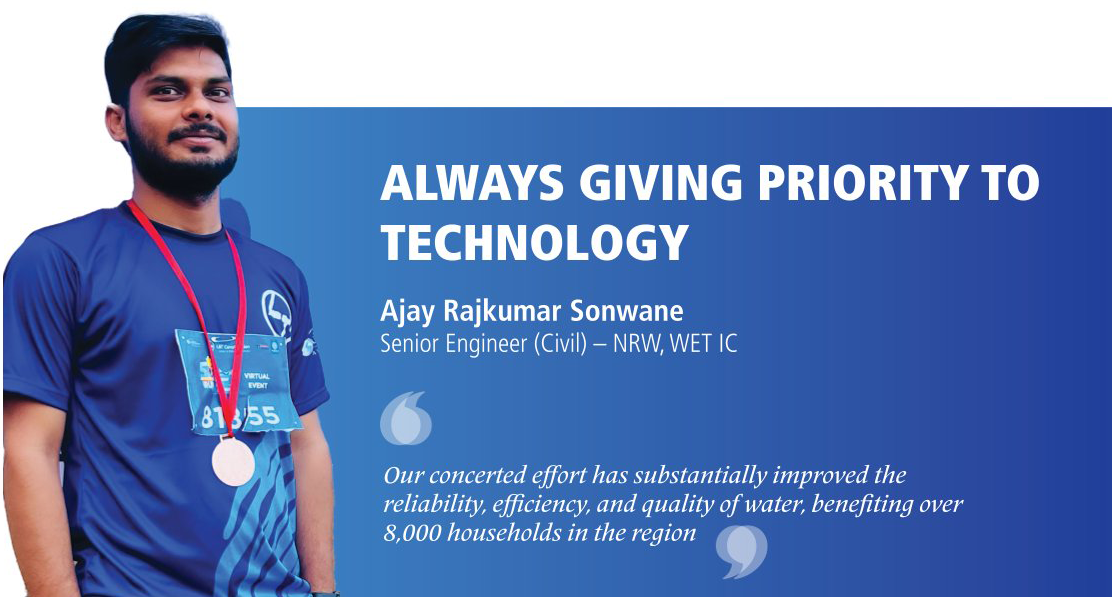
“I am delighted to be part of a team that always prioritizes advanced technologies and innovations to benefit our customers, clients and the environment,” beams Ajay Sonwane. “I am enjoying the opportunity to work on projects that are directly linked to communities and working with the public.” After completing his first project, the Veolia India NMC 24×7 water supply project (700 MLD), where as junior engineer he was responsible for reducing non-revenue water, he is presently at the Hubballi Dharwad 24×7 water supply project since December 2022 as Senior Engineer in the O&M department. “My responsibilities cover all the billing processes relating to water to consumers and to reduce non-revenue water.”
As technology interventions, Ajay mentions the deployment of the pipeline endoscopy camera system, to resolve issues of contamination, low-pressure and lack of water supply. “Our concerted effort has substantially improved the reliability, efficiency, and quality of water, benefiting over 8,000 households in the region,” he remarks encouragingly. To address the leakages occurring due to the old existing pipeline network, the team utilizes ground microphones and noise leak correlators. “By conducting extensive leak detection surveys in identified leakage prone / high consumption areas during nighttime to avoid disruptions, we have successfully pinpointed, arrested, and resolved more than 200 long-pending leakage / no-water complaints within a stipulated timeline, benefitted 4,000+ households.”
In addition, the team has implemented online monitoring systems to track flow and reservoir levels real time, fixed portable ultrasonic flow meters to measure flow in specific areas and arrest losses, and by calculating demand, the team is better informed to decide on ensuring equitable water supply and improve the supply cycle. “At my first project, we had introduced Google dashboards to monitor real-time progress activity wise for analysis,” Ajay reminds.
He has been strengthened by the support of his seniors to stay updated with new technologies and innovations both within and outside the work environment. “As a team, we collaborate effectively, sharing individual views and experiences to optimize the implementation of new technologies,” he remarks positively. More training programmes and better integration of new technologies into the existing systems are, according to Ajay, effective ways to drive technology.
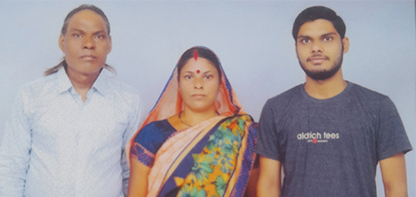
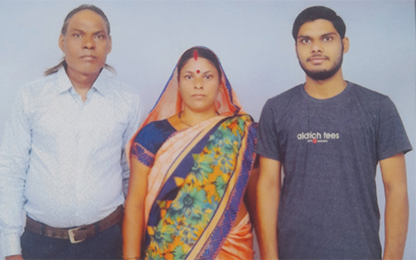
A native of Birsi (Amgaon), Maharashtra, Ajay, who is still single, likes to travel to new locations and, unsurprisingly, loves reading about and adapting new technologies and innovations. Being recognized by the top management for successfully completing a 5 km run to celebrate the World Water Day is one of his more cherished moments.
FLOW UNINTERRUPTED
Muthu M
Engineer (Civil) – NRW, WET IC
WET IC employees are often delighted when their efforts translate into changing peoples’ lives, and it is no different with M Muthu, who as part of the Hubbali–Dharwad Water Supply Project, has successfully reduced water wastage by providing reliable and sustainable 24×7 water supply to the residents. “As of now we have inspected over 25 kms of pipeline, identified and resolved 62 complaints that have resulted in substantial improvements in the reliability, efficiency, and quality of water, benefiting over 450 households in the region,” he shares with great satisfaction.

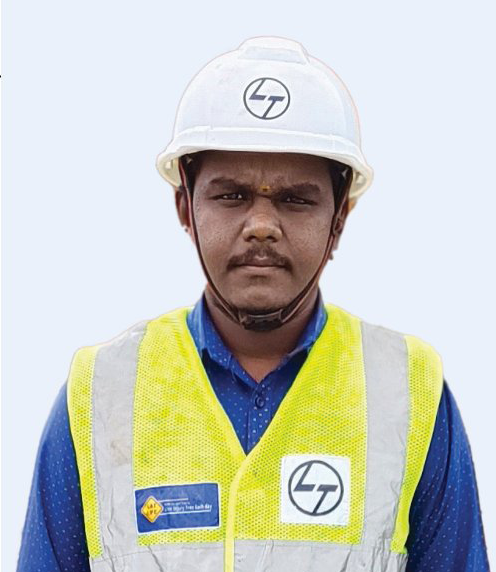
Identifying invisible leaks and addressing contamination issues in the pipelines are what the team has been contending with, apart from resolving customer grievances through a 24/7 customer care service, for which technology has been helping them big time. “We have implemented a range of advanced technologies at our project like portable flow meters, ground microphones, Leak Noise Correlators, and pipe endoscopy cameras to improve the water supply system,” Muthu flags off.
Using the leak noise correlators and the ground microphones and conducting extensive leak detection surveys in the night to avoid noise disruptions, the team has saved an impressive 0.43 MLD of water and resolved 23 long-pending leakage complaints providing water to 800+ households. Elaborating on leak detection, he explains that they use GIS data & historical patterns to identify leak prone zones. “We then deploy ultrasonic portable flow meters to measure rate of water flow and consumption levels in the targeted areas in real time. These flow meters are accurate, non-invasive, and can precisely monitor water usage,” he adds with a thumbs up.
Muthu agrees that access to advanced data analytical tools can help teams to understand & manage the water supply systems better and that the integration of IoT devices to control and manage water distribution will improve efficiency. He opines that structured and frequent training programmes combined with new technology in existing systems will quicken technology adoption.
“My seniors ensure my exposure to all the latest technological advancements, and if I am a Tech Champ today, it is all thanks to their guidance and support,” he says with due earnestness, thanking his team members too for their active collaboration, sharing of insights, constructive feedback, and support to implement new technologies.
A tech buff who is still single, Muthu is always on the lookout to learn and adopt new technologies. A native of Kattumannarkoil, Tamil Nadu, he finds time to travel and explore too. He proudly raises his head for being recognized by the senior management for his work in cost reduction, new process implementation and customer focused initiatives.

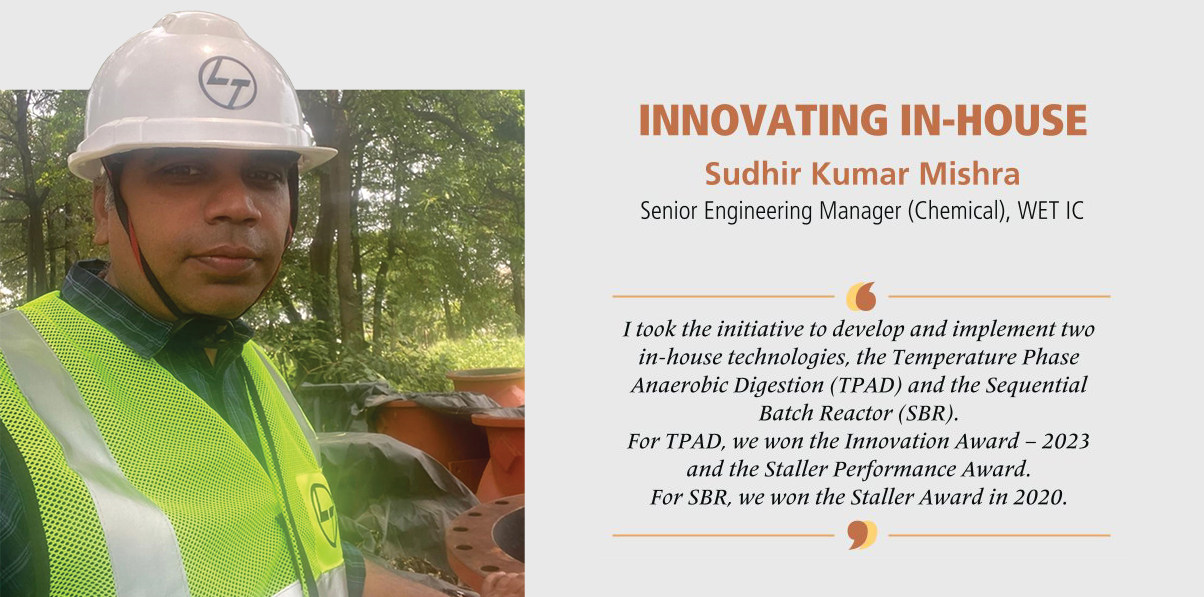
As Senior Process Engineering Manager, Sudhir Mishra possesses rich experience having been associated with important projects like the 136 MLD Chandigarh STP, where the team developed India’s first centralized Class A sludge treatment facility, the 120 MLD Varanasi STP that houses India’s largest advance UV disinfection system, and the 318 MLD Coronation Pillar STP that features India’s largest disc filter system.
Scope changes requiring design modifications and re-engineering leading to cost overruns and project delays are what irk Sudhir the most. “We therefore are prepared with two to three scenarios and standardize and digitize most of the design components to deliver speedily and accurately,” he points out. To overcome the reluctance of some of their clients to adopt new technologies, the team conducts regular workshops and shares documents reviewed by industry experts. To drive tech adoption internally, Sudhir advocates sharing success stories & demonstrating benefits to inspire employees to become technology advocates. “It is important to pilot new technologies in smaller spaces and gather feedback for refinement before scaling them up for wider implementation,” he shares wisely.
He attributes his success to his seniors & team members for sharing their experience to navigate through tough times, challenge status quo and think out of the box.
Hailing from Varanasi, Sudhir’s better half is Anshu, a purchase officer in Monarch Meditech, a medical equipment manufacturer, and their two children are son, Shirsh, and daughter, Priyanshi. He is inspired and guided by reading the scriptures; cherishing the day he was initiated into this tradition by his Guru. He loves long bike rides too.
Proud to be a part of a future ready organisation that is committed to innovation and sustainability, Sudhir believes that L&T offers infinite opportunities to grow, and it is up to every individual to capture them, take bold decisions and move ahead.

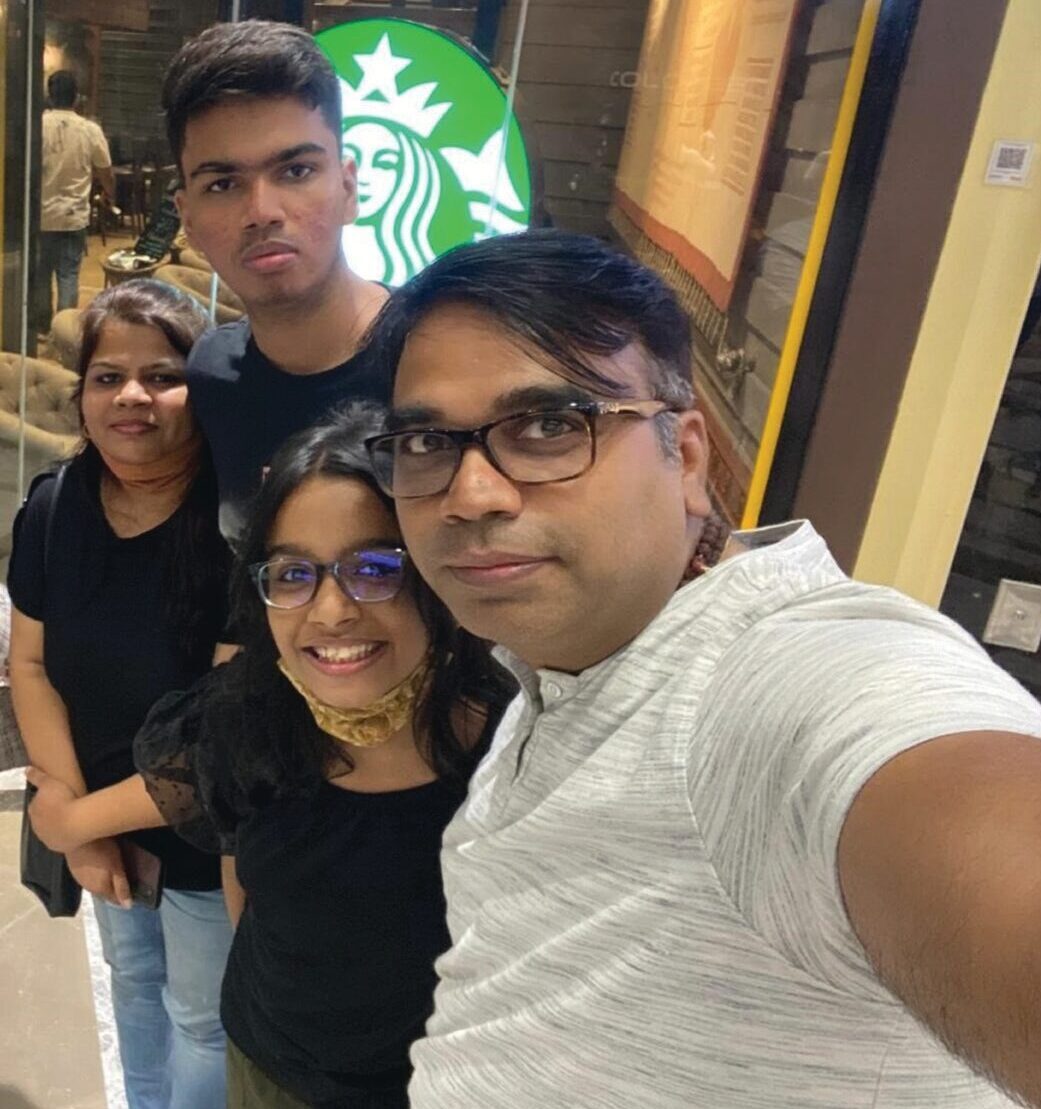
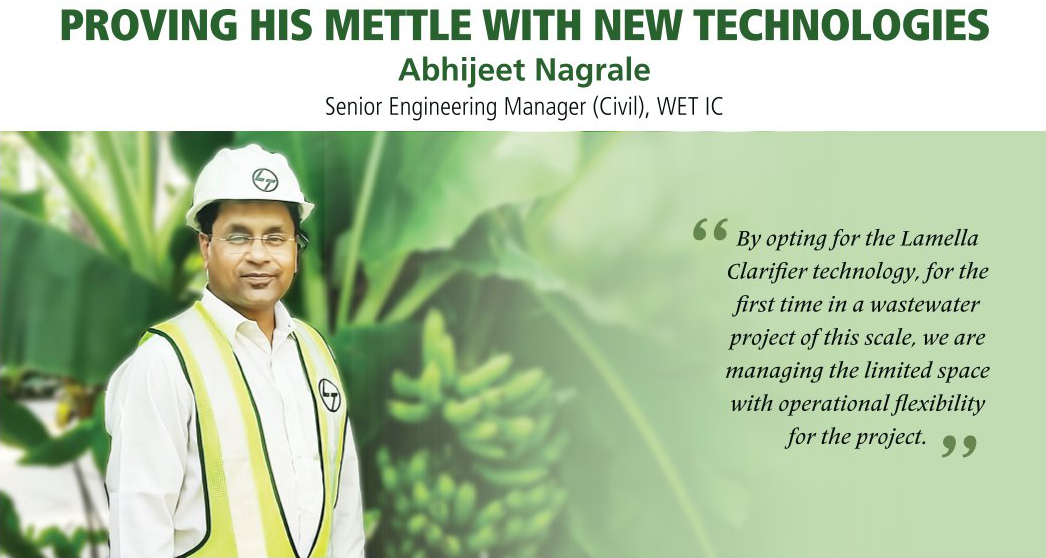
As the Lead Engineer, Abhijeet Nagrale and team have their task cut out at the 360 MLD Bandra Sewage Treatment Plant (STP), executing within the confines of the bustling city of Mumbai, but he is enjoying his opportunities to work on new technologies. “While we are using MBR technology for the first time on such a large scale project, completing our engineering drawings in BIM within 9 months along with the necessary approvals was a seriously big achievement,” he shares jubilantly.
Executing the drawings in BIM and a virtual digital studio is helping the team save time and deliver faster, he adds. “By opting for the Lamella Clarifier technology, for the first time in a wastewater project of this scale, we are managing the limited space with operational flexibility for the project, where Class ‘A’ sludge quality and deep aeration system are some of the adopted technologies.”
Attributing his success to his team, he smiles, “They have been adaptive at every stage of the project to deliver with quality and perfection. My seniors have been equally supportive, and I am grateful for their trust and confidence.”
Abhijeet fondly recalls his first L&T project at Bhatpara, Kolkata. As the Lead Engineering Manager, his mandate was to design, execute and commission a unique plant based on Fixed Bed Activated Sludge (FBAS) technology from Hungary. Apart from handling the new technology with elan, drawing from his rich experience, he is overjoyed at having grown a banana plant inside the aeration tank as the project had an in-built flora & fauna ecosystem. “Our project won the EEF (Energy & Environment Foundation) Global Wastewater Project Award,” he beams.
He is proud too of his contribution at a Nellore project where the team successfully reduced the number of STPs from 11 to 5 without compromising on the treatment capacity, saving cost too in the process. “We were recognized as the Best STP and won the Green Award from the Times Group.”
Abhijeet looks forward to adopting new, innovative, energy neutral technologies that use lesser footprint. On the digital side, he would like to dig deeper into data and use AI-powered software packages to create automated & accurate designs.
A native of Hyderabad (Telangana), Abhijeet and his wife, Revathi, a homemaker, are blessed with a daughter Bhavika. A lover of music, badminton and traveling, some of his life’s more memorable moments include the birth of his daughter, his interview at the L&T and his first project.
A proud L&T‑ite, Abhijeet is impressed with L&T’s visionary leadership and the freedom he enjoys to express his ideas and pursue them.


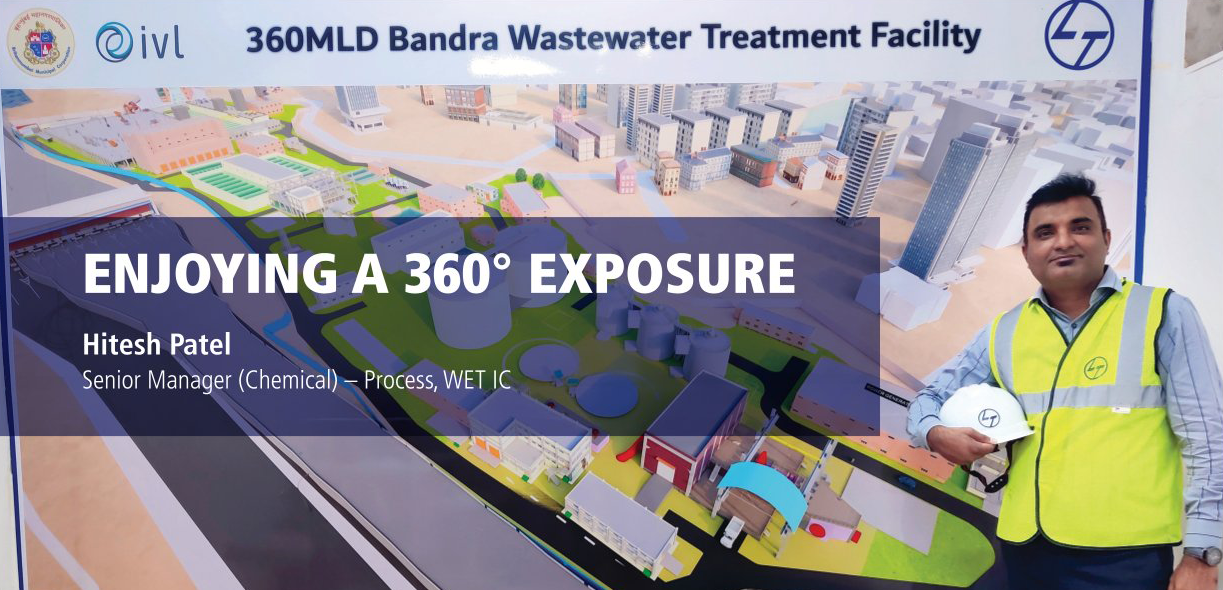

“I am thankful to L&T for giving me a 360° exposure in project execution, contracts management, and business development in this great career journey till date that began as a PGET in 2008,” declares Hitesh Patel, in awe of the company he keeps. A BIS Scholar, his 15-year journey includes a stint overseas in the Middle East, and his ‘concept to commissioning’ experience gained there in designing and successfully executing mega STPs is helping him now to value-add to innovate and introduce cost-effective design and implement technology.
Certainly, his current assignment as Design & Project Manager (MEICA) at the 360 MLD Bandra WwTF Project in Mumbai, his fourth, has been his most challenging where the team has deployed MBR Technology, Class A sludge treatment, and environment-friendly odour control system with most of the designs developed in-house. “We have used advanced simulation techniques for process optimization and increasing the plant efficiency by selecting the most suitable equipment,” he remarks.
On the tech adoption front, the project has been a lead runner and Hitesh’s mantra of ‘adopt & implement’ has driven the team to deploy BIM 5D, AR, & VR and develop a digital studio at site. “It was a daunting challenge to develop a comprehensive plant layout in non-liner geometry and gain the client’s confidence for the design,” he says grimly. “But with my international experience, I was able to guide the team to develop the layout and get all the approvals from various authorities.” His smile eloquently reflects their client’s appreciation. “I have also earned the prestigious PMP Certification from PMI, USA,” he grins triumphantly.
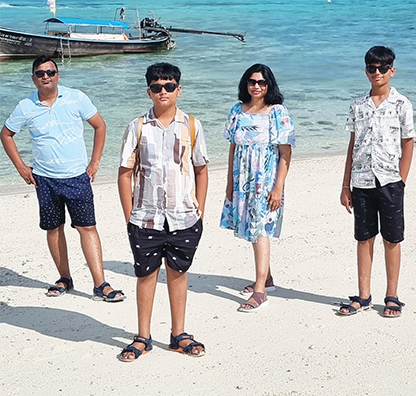
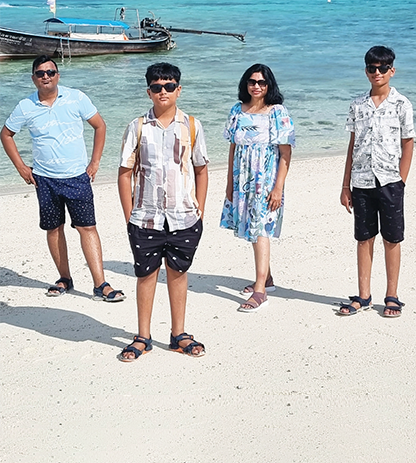
Hitesh feels fortunate to be working with a good mix of ‘experienced leaders’ and a ‘young fleet’, especially at his present project. “The support from my senior colleagues and the collaboration from the entire team have guided me at different milestones,” he says emotionally, “and if today I have been recognized as a Tech Champ, I owe a lot to them. I am excited and motivated to deliver more going forward and I respect the empowerment that I enjoy at L&T to take decisions that opens limitless opportunities.”
A native of Baroda, Gujarat, Hitesh’s most memorable moment was when he and his wife, Dr Dipti Patel, who works in the research and academia field, were blessed with twin boys, Kanishk & Kavan. “Watching them grow together every day makes my life complete,” he says dreamily. He makes sure that he takes a break to travel to new places every year.
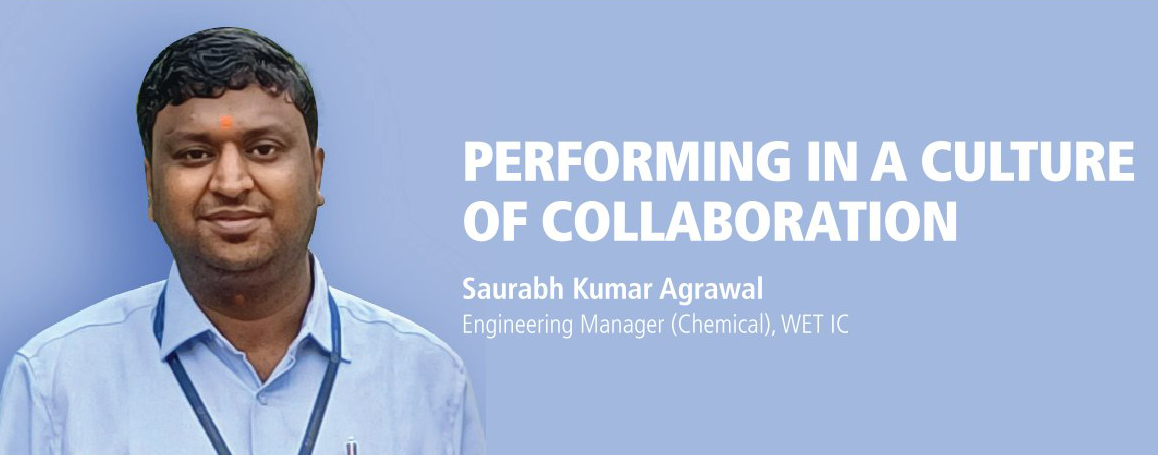
“Throughout my career, challenges I have encountered have demanded strategic solutions that I have successfully navigated thanks to our culture of collaboration,” declares Saurabh Agrawal, sharing the reason for his continued success at L&T. “We actively share knowledge and resources, ensuring that all of us are continuously learning and staying updated with the latest technological advancements. My team encourages innovative thinking and experimentation, giving me the freedom to explore new ideas and technologies, fostering a creative problem-solving mindset.”

Throughout his tenure that includes stints at the Barrackpore 6 & 18 MLD Sequential Batch Reactor–Based STP and Rourkela 40 MLD Sequential Batch Reactor–Based STP, and presently as Process Engineering Manager at the Bandra 360 MLD STP Membrane Bioreactor–Based STP, Saurabh has been conceptualizing process schemes, executing basic engineering packages, and overseeing detailed engineering phases. “My responsibilities extend to interacting with vendors, obtaining client/consultant approvals, value engineering and optimizing design, to enhance project profitability,” he shares.
About the tech interventions at the Bandra project, Saurabh initiated the design of MBR Technology, in-house developed TPAD Technology, ultraviolet radiation for disinfection and Rotary Drum Thickener, additionally mentioning a digital studio set up to view project visuals in high definition and an in-house developed Vendor Engineering Portal for EDRC that as a single source for information on the day-to-day progress made in vendor engineering across projects. “With dedicated tabs for a Management Console, it meets the requirements across various tiers too,” he adds.
Managing complex processes involve conducting detailed feasibility studies, collaborative brainstorming and leveraging advanced simulations to optimize efficiency and cost-effectiveness. “We obtained timely client and consultant approvals with our proactive communication and comprehensive documentation to meet timelines and our structured approach with clear milestones and rigorous quality checks are keeping us in good stead with our vendors,” Saurabh points out.
Recognized as a Tech Champ, Saurabh is convinced that the benefits of new technologies should be clearly communicated to all stakeholders for buy-in, supported by pilot projects. “Establishing mechanisms to continuously evaluate and improve technology solutions to keep pace with evolving needs and advancements is important too.”
A native of Begusarai, Bihar, Saurabh’s life partner is Hunny, a homemaker, and their joy is their daughter, Aarya, whose birth is his life’s most cherished moment. He has a special interest in personal finance, enjoying delving into personal finance books and watching videos featuring world-renowned financial influencers and teachers. “I also find it incredibly rewarding to stay informed about financial strategies, investments, and money management practices,” he signs off with a laugh.
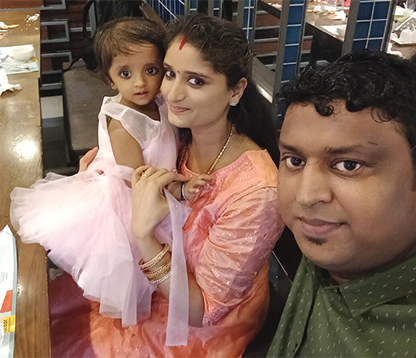


“Developing technological solutions in-house will not only make the company stronger but it will also reduce our dependence on vendors,” states Vasu K. “It is always better to implement advanced technology rather than being content with contract specifications as it gives us a technical advantage and benefits in terms of execution, cost, and operational efficiency.”
He believes in what he says for Vasu has experienced it at three of the six projects he has thus far been part of at L&T. At the NMDC Package No. 17–01 Project to construct a 216 MLD Water Treatment Plant and distribution system, the team implemented an Automatic Valveless Gravity Filter instead of the normal gravity filter system, he recalls. Later at the 100 MLD Desalination Project at Dahej for GIDC, Vasu refers to the implementation of Split Partial Technology in the RO System instead of the normal SWRO System by which downstream BWRO & upstream pretreatment capacity were reduced.
At his present assignment at the IOCL Barauni Project, Vasu mentions about the Spent Caustic Treatment Plant. “We are using Chemical Oxidation to reduce the sulphide content rather than opt for the WAO Technology which is a vendor package,” he shares. “We are also using SP PID & E3D software for P&ID & Model preparation.” Looking ahead, Vasu says that preparing Smart PID and Models in-house to deliver the BOQs in advance & clear interfaces will enormously help execution at site.


Vasu is extremely grateful for the support he has been receiving from teammates & superiors. “Our Process Head, Mr. Jaikumar, and IS, Mr. Premanand, have always guided and supported me to provide technical clarifications / justifications to client or PMC to complete the engineering.” He is very thankful to his team members Mr. Rajput Shivendra Singh, Ms. Divya, Ms. Niranjani and Mr. Ramesh too who have helped him to submit the engineering document as per schedule which is why he has been recognized as a Tech Champion.
A native of Keeramangalam, in Tamil Nadu’s Pudukkottai district, Vasu’s better half is S. Maharani, an educationalist, and they are blessed with two children, V. Mugundhan and V. Akshaya. “I love reading books and exercising and yes, I go for my regular jogs and gyming,” he laughs.
In conclusion, Vasu is a proud L&T‑ite for the Company operates in all sectors, working in accordance with environmental, ethical, and social principles.
In conclusion, Vasu is a proud L&T‑ite for the Company operates in all sectors, working in accordance with environmental, ethical, and social principles.
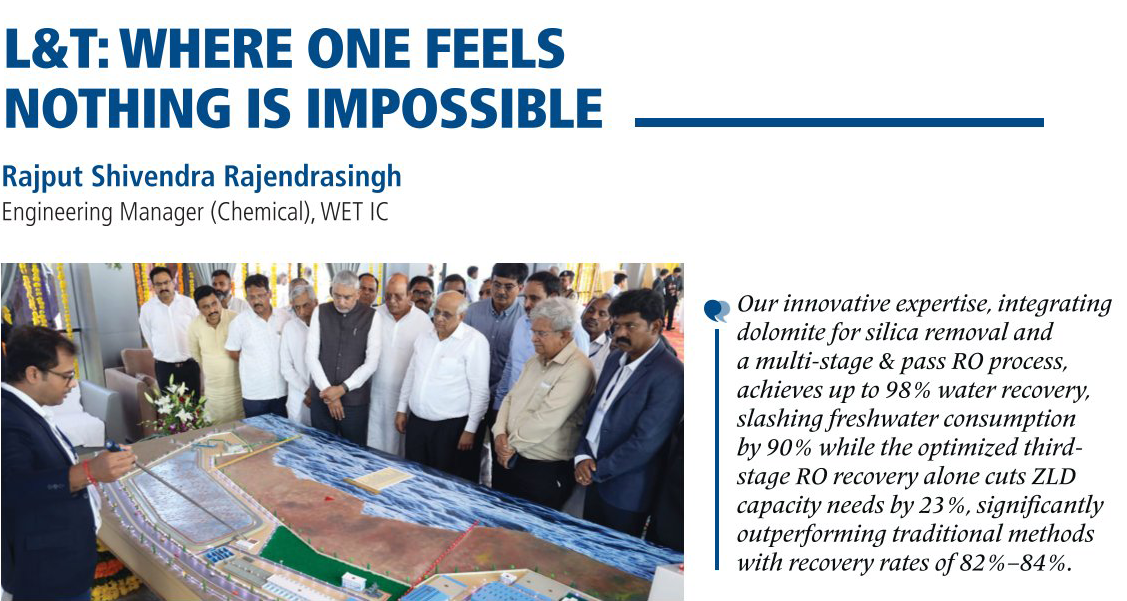
Proud of being with an organization where science & technology are both applied and celebrated, Rajput Shivendra Rajendrasingh describes L&T as a place where one feels that nothing is impossible; “a landmark where micro level interest of minds with creativity and hard work are creating colossal wonders,” he shares poetically. After joining in June 2014, he is already at his 6th project at the IOCL refinery project in Vadodara and has a lot to share about his association with technology.
“Our innovative expertise, integrating dolomite for silica removal and a multi-stage & pass RO process, achieves up to 98% water recovery, slashing freshwater consumption by 90% while the optimized third-stage RO recovery alone cuts ZLD capacity needs by 23%, significantly outperforming traditional methods with recovery rates of 82%–84%,” he shares.
“At IOCL, we implemented and handled 14 m³ /h × 2 multi-effect evaporator for the ZLD concept after the 3rd stage of RO reject, the Fenton process technology to remove phenol present in effluent in IOCL’s ETP in the Gujarat tender works, and again in the TFL project to remove cyanide present in effluents,” he informs. Rajput additionally mentions in-house designs for the complex biological removal system with technologies like UASB and trickling filters. “We have optimized the ZLD plant using TVR (Thermal Vapour Recompression), ATFD (Agitated Thin Film Dryer), and pusher centrifuge to deliver the salt and 10%–12% moisture content as desired by the end user,” he says with a punched fist.
Speaking of challenges, Rajput recalls having to convince IOCL & the PMC client for a revised scheme with increased recovery for 3 stages of ROs from the contract specification design and showcasing the reduced ZLD capacity with an innovative 5‑stage design to reduce the operating cost for power and steam.
Delighted with his team of “passionate process individuals, eager to take on new challenges, and always ready to support to deliver our objective with dedication and hard work,” Rajput flags off Ms. Divya, Ms. Niranjani, Mr. Surinder, and designers, Mr. Shankar K and Rajeshbabu N for their support & cooperation. “I wish we could prepare Smart PID & Models in-house with expertise to deliver the BOQs in advance and interface clearance to expedite execution at site,” he says, crystal ball gazing.
Hailing from Ahmedabad, Gujarat, Rajput’s life partner is Sarita Singh, a Centre Head in a leading school chain, and the apple of their eye is their son, Aayushman, who’s birth is his life’s most memorable moment. To unwind, he reads fiction, spiritual awareness, and history books, watches cricket, tennis, and badminton, listens to old melodies, and rides his beloved 350 cc.
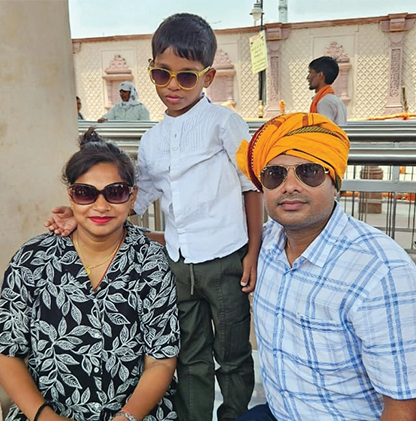


Although she is still finding her feet with L&T at her first assignment, WET IC’s IOCL Gujarat Refinery Project, S Divya is already enjoying the sweet taste of technology adoption that she readily agrees is improving their performance. “We have digitalized the deliverables like quantity estimates of valves, lines, instruments, etc. during detailed engineering using technologies like SPPID and SP3D tools and projected all the milestone reviews at 30%, 60%, and 90%,” she shares.
Referring to the ZLD plant-Multiple effect evaporator that has been identified as key new technology at her project, Divya explains that these systems are engineered to handle high Total Dissolved Solids (TDS) from rejected water by heating and circulating them to increase the salt concentration, which is then recovered. “The process is energy-intensive, but the benefits of salt recovery and reduced waste are substantial,” she remarks with a nod, and proceeds to explain the process.
After the MEE process, a salt dryer is often used to further reduce water content from the concentrated liquid, ensuring that the dry salt can either be disposed of or reused efficiently. The advanced membrane units within the MEE system can purify the brine solutions by removing residual impurities and recovering salts for reuse. “This not only exemplifies a sustainable approach to industrial waste management but also contributes to conserve resources by recycling valuable materials,” she says with vigour.
Timely completion of the process deliverables was a critical consideration for Divya and team because the subsequent work of other disciplines was dependent on their delivery. “By optimizing the schemes, prioritizing our tasks, and using some design tools we successfully achieved our huge target with the manpower provided,” she says with a smile of accomplishment.
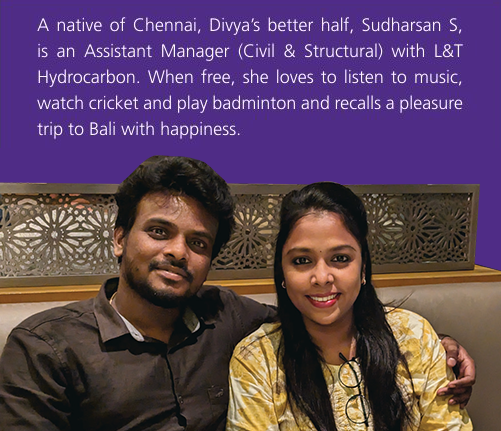
Divya is delighted with the team that she works with which is a big contributory factor for her success. “It is wonderful to have seniors like Jaikumar sir, Premanand sir, Vasu sir, and Shivendra sir who are ever willing to guide and help us, and their guidance has had a significant impact on the project’s success,” she shares earnestly. “It’s also wonderful that my team members are approachable, always ready to clarify even the smallest doubts and this collaborative environment has helped me learn and is very good for my career growth.” She is a proud L&Tian because of the Company’s commitment to success and high-quality service.